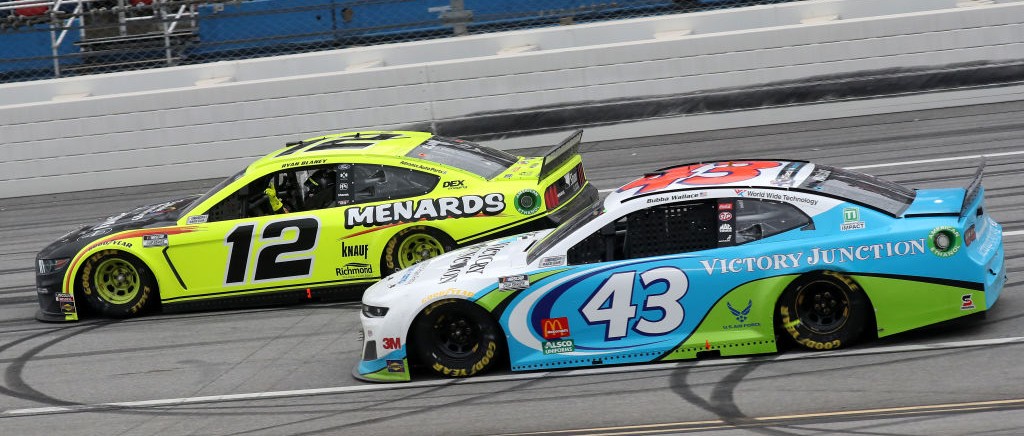NASCAR is in the midst of a change, as Bubba Wallace, the series’ lone Black driver, speaks out on the Black Lives Matter movement and successfully pushed NASCAR to ban Confederate flags from events.
The backlash to Wallace from a certain subset of NASCAR’s fan base, the ones that would like the sport to remain a safe space for racism, has been swift, but so has the support from new fans that want to watch races and cheer on Bubba. My Twitter timeline, which is typically fairly quiet during races given that I mostly follow folks interested in basketball, was more active than I’ve ever seen it in the last stage of Sunday’s race at Talladega.
As Wallace charged to the lead briefly and then battled in the top 10 for much of the final stage before being forced to pit on a late caution as he was running out of fuel, fans were enthralled by the action on the track — which, I must say is particularly unique to superspeedway racing at Talladega and Daytona — but also had plenty of questions.
I hope folks tuning in recently to support Wallace stick with NASCAR, a sport I’ve enjoyed watching for years but could desperately use an infusion of a younger, more diverse audience. As such, I’d like to try and answer some of those questions fans may have about terminology they hear on the race broadcast — I will say NASCAR broadcasts do a better job defining terms than most any other sports broadcasts — as well as some of the things that will happen during the race that may not be familiar to someone new to the sport.
Loose vs. Tight
You will hear announcers and drivers talking about their car being “loose” or “tight” throughout a race, sometimes with regards to one driver fighting both issues at the same time. That, unsurprisingly, is very bad. A loose race car means the rear tires lose traction first and make the back end of the car step out. The telltale sign of a loose race car is the back end sliding out in the corners, which can lead to spinning and wrecking. Sometimes, you’ll hear that one car forced another to “get loose,” which is the act of disrupting the air flow to the back bumper of the car, forcing the back end car start sliding up the track, which can lead to a spin or, at the least, forcing the other driver to really work the wheel to save it.
A tight race car means it doesn’t turn as much as the driver wants it to because the front tires lose traction before the rear tires, and this means they have a hard time sticking with the bottom line on the track. A driver with a tight race car will have to step out of the throttle to get the car to the bottom of the track or getting out of turns, losing speed in the process. Sometimes, a car can be both things, loose getting into turns and tight getting out. Again, that’s extra bad.
How do you fix these issues? That gets us to our next terms.
Trackbar, Wedge, Air Pressure Adjustments
Once a car is on the track there are three main ways for drivers and the crews to make adjustments to help the car’s handling. One is the track bar, which crews can adjust with a wrench that goes in the back windshield and drivers sometimes will adjust with a rod in the car (although some feel they only screw things up more when handling it themselves). The track bar runs underneath the rear of the car and can be raised or lowered to shift weight distribution from one side of the car to the other, and can change how it handles to either tighten or loosen up the car.
A wedge adjustment can only happen on a pit stop and requires a crew member to adjust the tension in the rear spring of the car. Sometimes you’ll hear about them calling to add wedge or taking out wedge during a pit stop. Adding wedge (increasing the spring tension) raises the car and makes it tighter, while taking out wedge (lowering the tension) lowers the car and loosens it up. Wedge adjustments are done in “rounds,” which is the amount the crew member will turn the ratchet. Sometimes it can be a quarter or half round, and sometimes it’ll be more than a full turn.
Finally, crews will toy with the air pressure in the tires to get the car to handle better. Lower air pressure will make a car tighter, while adding more air pressure will make the car looser. Most adjustments in air pressure are made to the right sides, particularly the right rear, because of how much force is put on the right sides on the banked corners.
Four Tires vs. Two Tires
For that same reason, that the right sides take more wear on the banked corners of NASCAR tracks, sometimes on key pit stops some drivers will take just two new tires (you might hear an announcer call them “stickers” because they’re new and came with the sticker on them still) on the right side rather than a full four to shorten their time on pit road and pick up some positions on the field. While that can be a good strategy for track position, if it’s done with too many laps left in a race, the worn left side tires will cause them to lose a bit of speed and the cars that take four tires will be at an advantage. Sometimes guys will take no tires and just get a splash of fuel to ensure they can make it to the end (we saw this some at Talladega on Monday).
Green-White-Checker
This is the “overtime” format NASCAR introduced years back to keep races from ending under caution, which is the most anti-climactic finish and fans hated it. The fix was to ensure a race always gets at least one full lap under green before being officially called. The Green-White-Checker designation refers to the flag order, with the first lap starting with the green, the white flag indicating the last lap. Once the leader takes the white flag (crosses the start/finish line for the final lap) the next flag ends the race. Sometimes this can mean a yellow and a checker, but typically if there’s a wreck on the final lap that’s not towards the front of the field well before the finish line, they’ll keep the race green for the leaders to battle it out (as we saw this Monday at Talladega).
Stages
NASCAR recently introduced stages to each race, breaking them up into three segments in an effort to make things more competitive. The first two stages each award points to the drivers in the top 10, making them valuable to the race for the playoffs, and reward drivers for running up front, even if they have issues or wreck later on in the race. The stages also work to prevent as many runaway winners, as there were times when, over a 500 mile race, you’d end up with the majority of the field getting lapped by the eventual winner. Since a caution flag is thrown after each stage, it ensures fewer green flag pit stops, closer fields, more restarts (where action tends to happen) and incentivizes the early and middle portions of the race.
Drafting
One of the first things folks notice when watching NASCAR is how close the cars get to one another and to the wall. That’s all part of the plan to reduce drag and increase speed. At Talladega and Daytona, the 2.5 mile superspeedways on the circuit, the use of “tapered spacers” to reduce horsepower by limiting air flow to the engine, bunch up the field and you get the type of racing we saw Sunday, where they’re nose to tail 5-10 deep and three-wide all the way around the track. Most tracks aren’t quite like that, but drafting is key at all of them, both in pushing someone to the front and also drafting to gain on them and, potentially, “slingshot” by them by using the speed you pick up drafting off of them to pass.
“Bump-drafting” is an aggressive form of drafting where the car behind will literally bump into the car in front at nearly 200 miles per hour. Some tracks, like the superspeedways, this is encouraged because the cars stay “wide open” (full throttle) the entire way around the track. At other tracks, where you let off the throttle in the corners or have to even use the brakes, bump-drafting at the wrong time in the corners can send someone into wall.
Drafting is also done by “side-drafting,” which is when cars get real close to each other when running side-by-side, this is done to manipulate the air flow on the side of a car and push more air onto the other car’s spoiler, slowing it down. When a car breaks a side draft, the resulting pocket of air that gets quickly filled can disrupt the other car, getting them loose or slowing them down as well.







